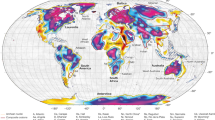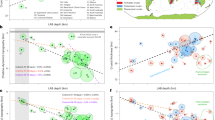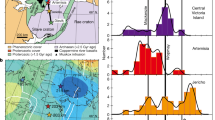Abstract
Cratons are the ancient cores of continents, characterized by tectonic inactivity, a thick mantle lithosphere and low heat flow. Although stable as tectonically independent units for at least the past 2 billion years, cratons have experienced episodic rejuvenation events throughout their history. The lower part of the lithosphere is first weakened and altered by impregnation of magma at a few locations, which produces local density anomalies that have a destabilizing effect. These altered zones coalesce to form linear incisions at the base of the craton. Lateral erosion of the lithosphere is further aided by small-scale convection resulting from variations in lithosphere thickness, proceeding eventually to large-scale sinking of lithospheric mantle. Oxidation of volatile-enriched mantle leads to a significant drop in melting temperature as redox processes dominate melting mechanisms in cratonic mantle. Reduced conditions dominate in the deepest lithosphere, in contrast to shallower levels where carbon — slowly accumulated as diamond — is remobilized by oxidation.
This is a preview of subscription content, access via your institution
Access options
Subscribe to this journal
Receive 12 print issues and online access
$259.00 per year
only $21.58 per issue
Buy this article
- Purchase on Springer Link
- Instant access to full article PDF
Prices may be subject to local taxes which are calculated during checkout




Similar content being viewed by others
References
Pollack, H. Cratonization and thermal evolution of the mantle. Earth Planet. Sci. Lett. 80, 175–182 (1986).
Condie, K. C. & Benn, K. in Archean Geodynamics and Environments (eds Benn, K., Mareschal, J.-C. & Condie, K. C.) 47–59 (American Geophysical Union, Washington DC, 2006).
Hoffman, P. United plates of America, the birth of a craton: Early Proterozoic assembly and growth of Laurentia. Ann. Rev. Earth. Planet. Sci. 16, 543–603 (1988).
Yang, J.-H. et al. Mesozoic decratonization of the North China block. Geology 36, 467–470 (2008).
Kuznir, N. J. & Park, R. G. The strength of intraplate lithosphere. Phys. Earth Planet. In. 36, 224–235 (1984).
Michaut, C., Jaupart, C. & Mareschal, J.-C. Thermal evolution of cratonic roots. Lithos 10.1016/j.lithos.2008.05.1008 (2008).
O'Neill, C. J., Lenardic, A., Griffin, W. L. & O'Reilly, S. Y. Dyanmics of cratons in an evolving mantle. Lithos 102, 12–24 (2008).
King, S. D. & Anderson, D. L. Edge-driven convection. Earth Planet. Sci. Lett. 160, 289–296 (1998).
Richardson, S. H., Gurney, J. J., Erlank, A. J. & Harris, J. W. Origin of diamonds in old enriched mantle. Nature 310, 198–202 (1984).
Boyd, F. & Gurney, J. Diamonds and the African lithosphere. Science 272, 472–477 (1986).
Tappe, S. et al. Craton reactivation on the Labrador Sea margins: Ar-40/Ar-39 age and Sr-Nd-Hf-Pb isotope constraints from alkaline and carbonatite intrusives. Earth Planet. Sci. Lett. 256, 433–454 (2007).
Wyllie, P. J. The origin of kimberlite. J. Geophys. Res. 85, 6902–6910 (1980).
Ringwood, A., Kesson, S., Hibberson, W. & Ware, N. Origin of kimberlites and related magmas. Earth Planet. Sci. Lett. 113, 521–538 (1992).
Mitchell, R. H. Kimberlites: Mineralogy, Geochemistry and Petrology. (Plenum Press, New York, 1986).
Simon, N. S. C. et al. The origin of garnet and clinopyroxene in “depleted” Kaapvaal peridotites. Lithos 71, 289–322 (2003).
Richardson, S. H. & Harris, J. W. Antiquity of peridotitic diamonds from the Siberian craton. Earth Planet. Sci. Lett. 151, 271–277 (1997).
Westerlund, K. J. et al. A subduction wedge origin for Paleoarchean peridotitic diamonds and harzburgites from the Panda kimberlite, Slave craton: evidence from Re-Os isotope systematics. Contrib. Mineral. Petr. 152, 275–294 (2006).
Stachel, T. et al. Archean diamonds from Wawa (Canada): samples from deep cratonic roots predating cratonization of the Superior Province. Contrib. Mineral. Petr. 151, 737–750 (2006).
Stachel, T. Diamonds from the asthenosphere and the transition zone. Eur. J. Mineral. 13, 883–892 (2001).
Brenker, F. E., Stachel, T. & Harris, J. W. Exhumation of lower mantle inclusions in diamond: A TEM investigation of retrograde phase transitions, reactions and exsolution. Earth Planet. Sci. Lett. 198, 1–9 (2002).
Shirey, S. B., Richardson, S. H. & Harris, J. W. Integrated models of diamond formation and craton evolution. Lithos 77, 923–944 (2004).
Richardson, S. H., Harris, J. W. & Gurney, J. J. Three generations of diamonds from old continental mantle. Nature 366, 256–258 (1993).
Shirey, S. B. et al. Regional patterns in the paragenesis and age of inclusions in diamond, diamond composition, and the lithospheric seismic structure of Southern Africa. Lithos 71, 243–258 (2003).
Shimizu, N. & Sobolev, N. V. Young peridotitic diamonds from the Mir Kimberlite pipe. Nature 375, 394–397 (1995).
Jacob, D. E., Viljoen, K. S., Grassineau, N. & Jagoutz, E. Remobilization in the cratonic lithosphere recorded in polycrystalline diamond. Science 289, 1182–1185 (2000).
Taylor, W. R. in Stable Isotopes and Fluids in Mineralization (ed. Ho, S.) 333–349 (Geological Society of Western Australia, Perth, 1990).
Deines, P., Viljoen, F. & Harris, J. W. Implications of the carbon isotope and mineral inclusion record for the formation of diamonds in the mantle underlying a mobile belt: Venetia, South Africa. Geochim. Cosmochim. Ac. 65, 813–838 (2001).
Pal'yanov, Y. N. et al. Diamond formation through carbonate-silicate interaction. Am. Mineral. 87, 1009–1013 (2002).
Gunn, S. C. & Luth, R. W. Carbonate reduction by Fe-S-O melts at high pressure and high temperature. Am. Mineral. 91, 1110–1116 (2006).
Bell, D. R. et al. Silica and volatile-element metasomatism of Archean mantle: a xenolith-scale example from the Kaapvaal craton. Contrib. Mineral. Petr. 150, 251–267 (2005).
Simon, N. S. C., Carlson, R. W., Pearson, D. G. & Davies, G. R. The origin and evolution of the Kaapvaal cratonic lithospheric mantle. J. Petrol. 48, 589–625 (2007).
Konzett, J., Armstrong, R. A. & Gunther, D. Modal metasomatism in the Kaapvaal craton lithosphere: constraints on timing and genesis from U-Pb zircon dating of metasomatized peridotites and MARID-type xenoliths. Contrib. Mineral. Petr. 139, 704–719 (2000).
Burgess, S. R. & Harte, B. Tracing lithosphere evolution through the analysis of heterogeneous G9-G10 garnets in peridotite xenoliths, II: REE chemistry. J. Petrol. 45, 609–634 (2004).
Tang, Y.-J. et al. Refertilization of ancient lithospheric mantle beneath the central North China Craton: evidence from petrology and geochemistry of peridotite xenoliths. Lithos 101, 435–452 (2008).
Glaser, S. M., Foley, S. F. & Günter, D. Trace element compositions of minerals in garnet and pinel peridotite xenoliths from the Vitim volcanic field, Transbaikalia, eastern Siberia. Lithos 48, 263–285 (1999).
Wass, S., Henderson, P. & Elliott, C. Chemical heterogeneity and metasomatism in the upper mantle: evidence from rare earth and other elements in apatite-rich xenoliths in basaltic rocks from eastern Australia. Phil. Trans. R. Soc. Lond. A 297, 333–346 (1980).
Witt-Eickschen, G. and O'Neill, H. S. The effect of temperature on the equilibrium distribution of trace elements between clinopyroxene, orthopyroxene, olivine and spinel in upper mantle peridotite. Chem. Geol. 221, 65–101 (2005).
Eggins, S., Rudnick, R. & McDonough, W. The composition of peridotities and their minerals: a laser-ablation ICP-MS study. Earth Planet. Sci. Lett. 154, 53–71 (1998).
Foley, S. F., Andronikov, A. V., Jacob, D. E. & Melzer, S. Spinel+garnet lherzolites from the Jetty Peninsula, East Antarctica: mineralogical features and geotherms in the mantle beneath a developing rift. Geochim. Cosmochim. Ac. 70, 3096–3120 (2006).
Gaul, O. F., Griffin, W. L., O'Reilly, S. Y. & Pearson, N. J. Mapping olivine composition in the lithospheric mantle. Earth Planet. Sci. Lett. 182, 223–235 (2000).
Eggler, D. H. & Furlong, K. P. Destruction of subcratonic mantle keel: the Wyoming province. 5th Kimberlite Conf. Ext. Abs. 85–87 (1991).
Xu, Y. G. Thermo-tectonic destruction of the archaean lithospheric keel beneath the Sino-Korean Craton in China: Evidence, timing and mechanism. Phys. Chem. Earth A 26, 747–757 (2001).
Guo, F., Fan, W. M., Wang, Y. J. & Lin, G. Geochemistry of late Mesozoic mafic magmatism in west Shandong Province, eastern China: Characterizing the lost lithospheric mantle beneath the North China Block. Geochem. J. 37, 63–77 (2003).
Xu, Y. G. et al. Role of lithosphere-asthenosphere interaction in the genesis of Quaternary alkali and tholeiitic basalts from Datong, western North China Craton. Chem. Geol. 224, 247–271 (2005).
Rudnick, R. L. et al. Petrology and geochemistry of spinel peridotite xenoliths from Hannuoba and Qixia, North China craton. Lithos 77, 609–637 (2004).
Weeraratne, D. S., Forsyth, D. W., Fischer, K. M. & Nyblade, A. A. Evidence for an upper mantle plume beneath the Tanzanian craton from Rayleigh wave tomography. J. Geophys. Res.—Sol. Ea. 108, 2147 (2003).
Ritsema, J. et al. Upper mantle seismic velocity structure beneath Tanzania, east Africa: Implications for the stability of cratonic lithosphere. J. Geophys. Res.—Sol. Ea. 103, 21201–21213 (1998).
Sleep, N. H., Ebinger, C. J. & Kendall, J. M. in The Early Earth: Physical, Chemical and Biological Development Vol. 199 (eds Fowler, C. M. R., Ebinger, C. J. & Hawkesworth, C. J.) 135–150 (Geological Society of London, London, 2002).
King, S. D. & Anderson, D. L. An alternative mechanism of flood basalt formation. Earth Planet. Sci. Lett. 136, 269–279 (1995).
Lebedev, S., Meier, T. & Van Der Hilst, R. D. Asthenospheric flow and origin of volcanism in the Baikal Rift area. Earth Planet. Sci. Lett. 249, 415–424 (2006).
Doblas, M. et al. Mantle insulation beneath the West African craton during the Precambrian-Cambrian transition. Geology 30, 839–842 (2002).
Petit, C. & Ebinger, C. Flexure and mechanical behavior of cratonic lithosphere: Gravity models of the East African and Baikal rifts. J. Geophys. Res.—Sol. Ea. 105, 19151–19162 (2000).
Foley, S. Vein-plus-wall-rock melting mechanisms in the lithosphere and the origin of potassic alkaline magmas. Lithos 28 435–453 (1992).
Muntener, O., Piccardo, G. B., Polino, R. & Zanetti, A. Revisiting the Lanzo peridotite (NW-Italy): 'Asthenospherization' of ancient mantle lithosphere. Ofioliti 30, 111–124 (2005).
Ranalli, G., Piccardo, G. B. & Corona-Chavez, P. Softening of the subcontinental lithsopheric mantle by asthenosphere melts and the continental extension/oceanic spreading transition. J. Geodyn. 43, 450–464 (2007).
Beccaluva, L. et al. Intracratonic asthenosphere upwelling and lithosphere rejuvenation beneath the Hoggar swell (Algeria): evidence from HIMU metasomaized lherzolite xenoliths. Earth Planet. Sci. Lett. 260, 482–494 (2007).
Ebinger, C. et al. Rifting Archaean lithosphere: the Eyasi-Manyara-Natron rifts, East Africa. J. Geol. Soc. 154, 947–960 (1997).
Griffin, W. L. et al. The Siberian lithosphere traverse: mantle terranes and the assembly of the Siberian Craton. Tectonophysics 310, 1–35 (1999).
Elkins-Tanton, L. T. Continental magmatism, volatile recycling, and a heterogeneous mantle caused by lithospheric gravitational instabilities. J. Geophys. Res. 112, 03410.01029/02005JB004072 (2007).
Doig, R. An alkaline rock province linking Europe and North America. Can. J. Earth Sci. 7, 22–28. (1970).
Yuen, D. A. & Fleithout, L. Thinning of the lithosphere by small-scale convective destabilization. Nature 313, 125–128 (1985).
Doin, M. P., Fleitout, L. & Christensen, U. Mantle convection and stability of depleted and undepleted continental lithosphere. J. Geophys. Res.—Sol. Ea. 102, 2771–2787 (1997).
Artemieva, I. M. & Mooney, W. D. On the relations between cratonic lithosphere thickness, plate motions, and basal drag. Tectonophysics 358, 211–231 (2002).
Artemieva, I. M. Global 1 degrees x 1 degrees thermal model TC1 for the continental lithosphere: Implications for lithosphere secular evolution. Tectonophysics 416, 245–277 (2006).
O'Neill, C. J., Moresi, L. & Jaques, A. L. Geodynamic controls on diamond deposits: Implications for Australian occurrences. Tectonophysics 404, 217–236 (2005).
Becker, M. & Le Roex, A. P. Geochemistry of South African on- and off-craton, Group I and Group II kimberlites: petrogenesis and source region evolution. J. Petrol. 47, 673–703 (2006).
Andronikov, A. V. & Foley, S. F. Trace element and Nd-Sr isotopic composition of ultramafic lamprophyres from the East Antarctic Beaver Lake area. Chem. Geol. 175, 291–305 (2001).
Foley, S. F., Andronikov, A. V. & Melzer, S. Petrology, geochemistry and mineral chemistry of ultramafic lamprophyres from the Jetty Peninsula area of the Lambert-Amery Rift, Eastern Antarctica. Miner. Petrol. 74, 361–384 (2002).
Tappe, S. et al. Genesis of ultramafic lamprophyres and carbonatites at Aillik Bay, Labrador: A consequence of incipient lithospheric thinning beneath the North Atlantic craton. J. Petrol. 47, 1261–1315 (2006).
Tappe, S., Foley, S. F., Jenner, G. A. & Kjarsgaard, B. A. Integrating ultramafic lamprophyres into the IUGS classification of igneous rocks: Rationale and implications. J. Petrol. 46, 1893–1900 (2005).
Upton, B. G. J., Craven, J. A. & Kirstein, L. A. Crystallisation of mela-aillikites of the Narsaq region, Gardar alkaline province, south Greenland and relationships to other aillikitic-carbonatitic associations in the province. Lithos 92, 300–319 (2006).
Digonnet, S. et al. Petrology of the Abloviak Aillikite dykes, New Quebec: Evidence for a Cambrian diamondiferous alkaline province in northeastern North America. Can. J. Earth Sci. 37, 517–533 (2000).
Birkett, T. C., McCandless, T. E. & Hood, C. T. Petrology of the Renard igneous bodies: host rocks for diamond in the northern Otish Mountains region, Quebec. Lithos 76, 475–490 (2004).
Bailey, K. et al. Melilitite at Fort Portal, Uganda: Another dimension to the carbonate volcanism. Lithos 85, 15–25 (2005).
Green, D. H. & Falloon, T. J. in The Earth's Mantle: Composition, Structure and Evolution (ed. Jackson, I. S.) 311–388 (Cambridge University Press, Cambridge, 1998).
Scott, B. Kimberlite and lamproite dykes from Holsteinsborg, West Greenland. Medd. Grønland 4, 3–24 (1981).
Williams, L. A. J. in Continental and Oceanic Rifts (ed. Pàlmason, G.) 193–222 (American Geophysical Union, Washington, D. C., 1982).
Neumann, E. R., Olsen, K. H., Baldridge, W. S. & Sundvoll, B. The Oslo Rift — a review. Tectonophysics 208, 1–18 (2002).
Taylor, W. & Green, D. Measurement of reduced peridotite–C–O–H solidus and implications for redox melting of the mantle. Nature 332, 349–352 (1988).
Dalton, J. A. & Presnall, D. C. Carbonatitic melts along the solidus of model lherzolite in the system CaO-MgO-Al2O3-SiO2-CO2 from 3 to 7 GPa. Contrib. Mineral. Petr. 131, 123–135 (1998).
Dasgupta, R. & Hirschmann, M. M. Melting in the Earth's deep upper mantle caused by carbon dioxide. Nature 440, 659–662 (2006).
Brey, G. P., Bulatov, V. K., Girnis, A. V. & Lahaye, Y. Experimental melting of carbonated peridotite at 6–10 GPa. J. Petrol. 49, 797–821. (2008).
Wallace, M. E. & Green, D. H. An experimental determination of primary carbonatite magma composition. Nature 335, 343–346 (1988).
Taylor, W. R. & Green, D. H. in Magmatic Processes: Physicochemical Principles (ed. Mysen B. O.) 121–137 (Geochemical Society, Washington DC, 1987).
Foley, S. F. The genesis of continental basic alkaline magmas — an interpretation in terms of redox melting. J. Petrol. Lithosphere Issue, 139–161 (1988).
Dalton, J. A. & Presnall, D. C. The Continuum of Primary Carbonatitic-Kimberlitic Melt Compositions in Equilibrium with Lherzolite: Data from the System CaO-MgO-Al2O3-SiO2-CO2 at 6 GPa. J. Petrol. 39, 1953–1964 (1998).
Dasgupta, R., Hirschmann, M. M. & Smith, N. D. Water follows carbon: CO2 incites deep silicate melting and dehydration beneath mid-ocean ridges. Geology 35, 135–138 (2007).
Foley, S. F. et al. Experimental melting of peridotites in the presence of CO2 and H2O at 40–60 kbar. 9th Int. Kimberlite Conf. Ext. Abs. 9IKC-A-00156 (2008).
Woodland, A. B. & Koch, M. Variation in oxygen fugacity with depth in the upper mantle beneath the Kaapvaal craton, Southern Africa. Earth Planet. Sci. Lett. 214, 295–310 (2003).
McCammon, C. & Kopylova, M. G. A redox profile of the Slave mantle and oxygen fugacity control in the cratonic mantle. Contrib. Mineral. Petr. 148, 55–68 (2004).
Zhao, D. G., Essene, E. J. & Zhang, Y. X. An oxygen barometer for rutile-ilmenite assemblages: oxidation state of metasomatic agents in the mantle. Earth Planet. Sci. Lett. 166, 127–137 (1999).
Canil, D. et al. Ferric iron in peridotites and mantle oxidation-states. Earth Planet. Sci. Lett. 123, 205–220 (1994).
Woodland, A. B., Kornprobst, J. & Tabit, A. Ferric iron in orogenic lherzolite massifs and controls of oxygen fugacity in the upper mantle. Lithos 89, 222–241 (2006).
Lee, C. T. A., Leeman, W. P., Canil, D. & Li, Z. X. A. Similar V/Sc systematics in MORB and arc basalts: Implications for the oxygen fugacities of their mantle source regions. J. Petrol. 46, 2313–2336 (2005).
Ballhaus, C. & Frost, B. R. The generation of oxidized CO2-bearing basaltic melts from reduced CH4-bearing upper-mantle sources. Geochimica et Cosmochimica Acta 58, 4931–4940 (1994).
Fedortchouk, Y. & Canil, D. Intensive variables in kimberlite magmas, Lac de Gras, Canada and implications for diamond survival. J. Petrol. 45, 1725–1745 (2004).
Canil, D. & Bellis, A. J. Ferric iron in CaTiO3 perovskite as an oxygen barometer for kimberlite magmas II: applications. J. Petrol. 48, 231–252 (2007).
Jaques, A. L., Lewis, J. D. & Smith, C. B. The Kimberlites and Lamproites of Western Australia (Geological Survey of Western Australia, Perth, 1986).
Foley, S. F. An Experimental-Study of Olivine Lamproite - 1st Results from the Diamond Stability Field. Geochim. Cosmochim. Ac. 57, 483–489 (1993).
Eaton, D. W. et al. The elusive lithosphere-asthenosphere boundary (LAB) beneath cratons. Lithos 10.1016/j.lithos.2008.05.009 (2008).
Acknowledgements
Work on alkaline rocks and cratons is supported by the Geocycles Cluster at Mainz and the Rift-Link Resarch Unit of the German Science Foundation. This is Geocycles publication No. 493. The manuscript benefited from the comments of W. Bleeker, D. Canil and N. Simon.
Author information
Authors and Affiliations
Rights and permissions
About this article
Cite this article
Foley, S. Rejuvenation and erosion of the cratonic lithosphere. Nature Geosci 1, 503–510 (2008). https://doi.org/10.1038/ngeo261
Published:
Issue Date:
DOI: https://doi.org/10.1038/ngeo261
This article is cited by
-
Plate tectonics in the Archean: Observations versus interpretations
Science China Earth Sciences (2024)
-
Rift-induced disruption of cratonic keels drives kimberlite volcanism
Nature (2023)
-
The evolution of diamond-forming fluids indicating a pre-kimberlitic metasomatic event in the mantle beneath the Mirny field (Siberian craton)
Contributions to Mineralogy and Petrology (2023)
-
Transient mobilization of subcrustal carbon coincident with Palaeocene–Eocene Thermal Maximum
Nature Geoscience (2022)
-
Diamonds, dunites, and metasomatic rocks formed by melt/rock reaction in craton roots
Communications Earth & Environment (2022)



